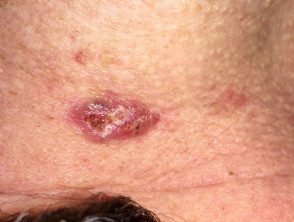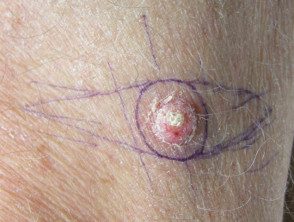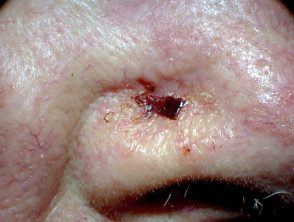What are they keratinocytes cancers?
A keratinocyte Cancer is a evil one neoplasm formed from epidermal cells that produce curb (keratinocytes) Keratinocyte cancers are classified as scaly cell carcinomas (SCC) and basal cell carcinomas (BCC).
Keratinocyte cancers are considered low or high risk, depending on patient factors such as age, immunosuppression state, histological subtype, and the site of the tumor in the body.
Keratinocyte cancers

Noducytic basal cell carcinoma

Squamous cell carcinoma in situ

Squamous cell carcinoma
What is a surgical margin?
A surgical margin is a clinical measurement performed just before a injury It is removed. The surgeon uses his naked eye or magnification (eg, a dermatoscope) to find the edge of the tumor, then measures the desired amount of normal skin to remove on both sides of the tumor. A surgical marker is used to plan excision site.
As a general guideline, the appropriate surgical margins are 3 to 4 mm for a CCB and at least 4 mm for a low-risk CCS. There are no published guidelines for a high-risk SCC.
Surgical margins

Basal cell carcinoma

Squamous cell carcinoma of the skin.

Squamous cell carcinoma of the skin
What are the histological margins?
A histological margin is measured by a pathologist. It describes the amount of normal tissue that borders a tumor sample.
- the side and deep margins are examined in several representative histological sections.
- A tumor involving any surgical margin has cancer cells on the edge of the sample.
- If all of the tumor margins are clear, there are no cancer cells at the edge of the sample.
- The number of sections evaluated varies and may represent only 1% from the edge of the tumor.
Why is the histological margin important?
Histological margins may be adequate, narrow, or inadequate.
- Narrow or inadequate margins may require close monitoring, additional surgery, or attached therapy (eg radiotherapy)
- Histological margins may have forecast value, including the probability of reappearance and metastasis.
What is an adequate histological margin?
A suitable histological margin is the acceptable distance of tumor cells from the histological margin, according to expert consensus and published research.
The desirable margin depends on the type of tumor and the technique used to remove it. Clinicopathological Correlation and additional sections may be useful, particularly when the clinical margins have been difficult to assess or compromised by the anatomical location of the tumor (eg, lesions of the midface).
Basal cell carcinoma
Adequate histological margins are generally:
- 0.5 mm for low risk CCB [1]
- 1mm for high risk CCB; BCCs can have irregular and unpredictable extensions. [two].
Squamous cell carcinoma
Margins greater than 1mm are considered adequate for high and low risk SCCs. [3].
Margins less than 1 mm require careful monitoring or additional treatment [3].
What are the high-risk characteristics of keratinocyte cancers?
The high-risk characteristics of each type of keratinocyte cancer are as follows.
Basal cell carcinoma
High risk BCC may have the following characteristics:
- Size ≥ 20 mm in the trunk or extremities or ≥ 10 mm in the cheeks, forehead, scalp, neck and pretibial sites
- Any injury to the central face, eyelids, eyebrows, periorbital area, nose, lips, chin, mandible, postauricular area, genitals, hands or feet
- Any aggressive histological subtype: morph form, sclerosing, mixed infiltrativeMicronodular or Basosquamous BCC
- Any tumor with perineural invasion
- None recurrent tumor
- Any tumor in a immunocompromised patient
- Any tumor in a previous radiation area.
- Any tumor with poorly defined edges. [4].
High-risk basal cell carcinoma

Large size, location close to the eye

Morphoeic subtype.

Poorly defined clinical margins
Squamous cell carcinoma
High-risk SCC can have the following characteristics:
- Size ≥ 20 mm in the trunk or extremities or size ≥ 10 mm in the cheeks, forehead, scalp, neck and pretibial sites
- Any injury to the central face, eyelids, eyebrows, periorbital area, nose, lips, chin, jaw, ear, post-ear area, genitals, hands or feet.
- Any wrong differentiated tumor
- Any tumor ≥ 4 mm thick in biopsy
- Any tumor with perineural, lymphaticor vascular invasion
- Any tumor in an immunocompromised patient.
- Any recurrent tumor [5].
High-risk squamous cell carcinoma.

Large size

Location in the ear

Recurrent tumor
Perineural invasion
Perineural invasion can be seen in histology in up to 5% from keratinocyte cancers. It presents a high risk of local recurrence, and in SCC, of metastasis. [6].
Tumors with perineural invasion should be referred to a specialist. Administration may include:
- Magnetic resonance imaging (Magnetic resonance)
- New division with wide margins
- Postoperative radiation therapy.
What is the treatment if the margins are inadequate?
Basal cell carcinoma
If histological margins are involved or inadequate, most low-risk CCBs should undergo further excision to ensure adequate margins. In selected cases, radiation therapy may be a reasonable alternative. Persistent superficial CCB can occasionally be treated topically (eg Imiquimod cream)
High-risk lesions improperly excised should be referred to a specialist, based on the skill of the physician and tumor factors. To reduce unnecessary removal of healthy tissue, Mohs micrographic surgery may be considered, especially for injuries in high-risk areas.
Squamous cell carcinoma
Histological margins of less than 1 mm should lead to a further excision of a SCC. Consider getting a referral for high-risk SCC, especially in the head and neck.
How common is keratinocyte cancer recurrence?
Recurrence of keratinocyte cancer depends on the type and risk category of the injury, the type of treatment, the histological margins, and the experience of the physician.
For low-risk CCBs treated by surgical excision:
- In one study, recurrence rates with surgical margins of 5, 4, 3, and 2 mm were 0.4%, 1.6%, 2.6%, and 4% respectively [7]
- In another study, the recurrence rate was 38% if histological margins were involved, 12% if histological margins were <0.5 mm, y del 1.2% para márgenes de 0.5 mm [8].
Recurrent basal cell carcinoma

Recurrent nodule at the cleared site with imiquimod cream

Pigmented recurrence at the edge of the skin graft

Scabbing inside the scar on the ear
What are the complications due to recurrent keratinocyte cancers?
Basal cell carcinoma
CCB rarely metastasis but it can cause local tissue destruction. Recurrent BCCs generally require more aggressive treatment resulting in increased tissue loss and surgical complications.
Squamous cell carcinoma
The development of local recurrence of SCC is associated with additional local recurrence in approximately 25% of the lesions and metastasis to the regional nodes in up to 30%. About a third of patients who develop regional metastases will die from SCC [9].
What is the treatment for recurrent keratinocyte cancers?
Basal cell carcinoma
Recurring BCC is treated by resection of the scar, the recurrent tumor and a margin of 3–4 mm of surrounding skin [10,11]. Referral to a specialist should be considered, especially if the edges of the tumor are difficult to detect. Mohs surgery may be indicated.
Squamous cell carcinoma
Referral to a specialist for recurrent SCC is recommended due to the risk of developing increased recurrence and metastasis.
What is the follow-up for recurrent keratinocyte cancer?
Follow-up requires inspection of the treated area by dermoscopy and palpation of adjacent structures [12].
- The 50% of BCC recurrences occur within the first year and the 80% within 5 years. [13].
- 70–80% of SCC recurrences occur in the first two years and ~ 95% in 5 years [14].
An annual skin check is recommended for all patients with a history of skin cancer.
- No additional follow-up is required after complete excision of SCC and low-risk BCC [2].
- The monitoring of a BCC with high-risk characteristics should be carried out every 6 months during the first year than annually [4].
- More intensive follow-up is recommended after non-surgical treatments have been used (eg, for superficial BCC) due to a higher recurrence rate, revision after 3 months, then revision every 6–12 months for 3 years. [two].
- Follow-up of SCC with high-risk characteristics is recommended after 3 months and then every 6 months; always examine the drain lymph node basin [2].
